Does restoring a vintage instrument really make it better?
I once interviewed Mark Karan, guitarist
extraordinaire for Ratdog and Jemimah
Puddleduck, and L.A. session guru and total
gearhound. Mark had a refreshing take on
gear. He told me, "Because I want to actually
use these instruments, I buy pieces that have
what collectors might call ‘issues,’ like non-
original hardware or having been refinished.
To me, it’s the old wood that matters, and as
long as the wood is there, I can find a way
around the issues. When I bought my ’51
Nocaster, I strummed it unplugged and knew
I couldn’t walk out of the store without that
guitar. And that’s one a collector wouldn’t be
caught dead with, simply because somebody
had slapped another type of paint on it."
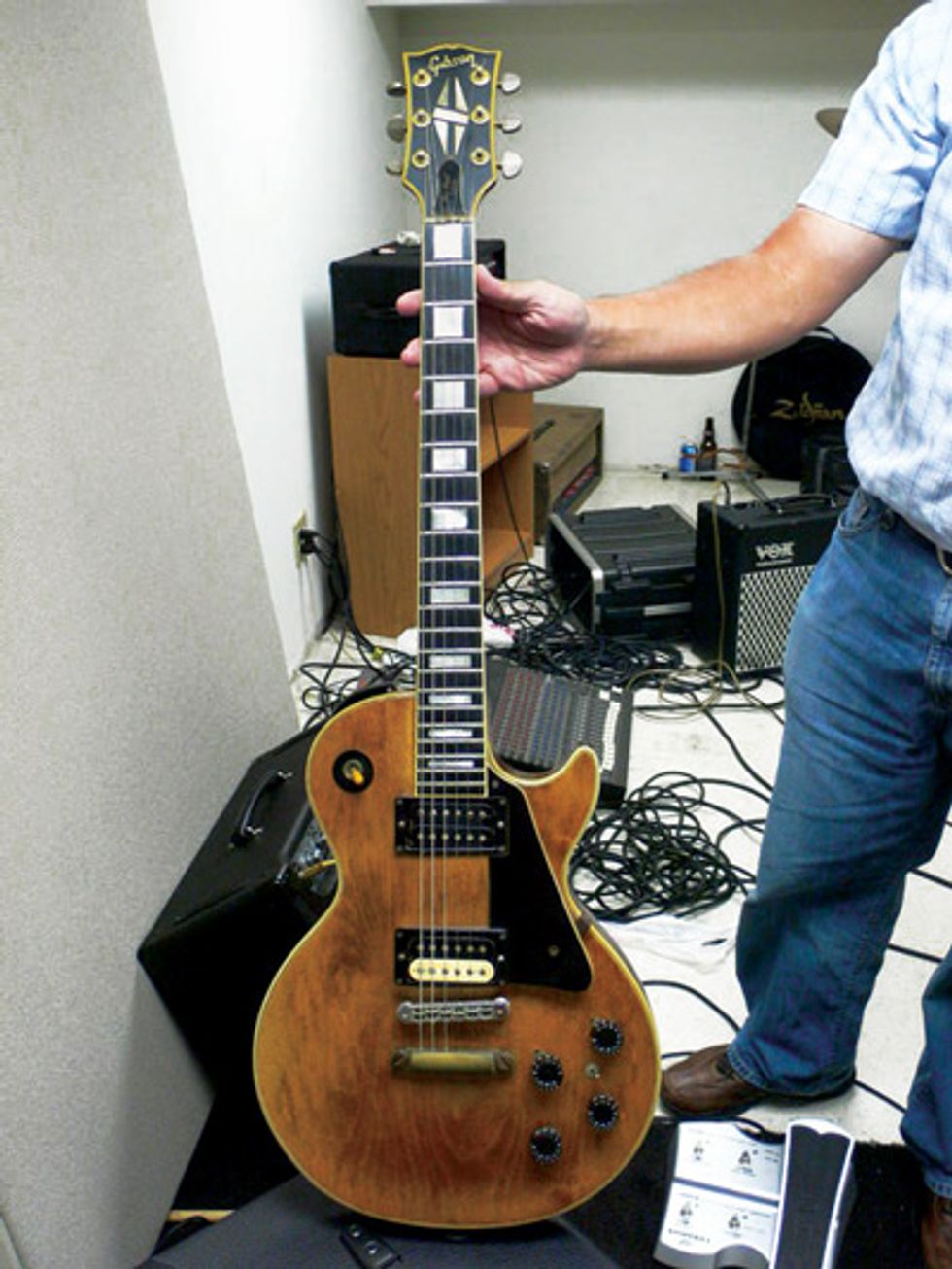
David Loo’s 1969 Les Paul Custom. Photo by Wallace Marx
You can see the wisdom. Get past the looks and listen to the tone. Avoid letting a few mods and perhaps ill-advised "upgrades" sway you, and ask yourself, "Do I like this guitar? And what does it matter what the snobs say?" Mark got what would turn out to be his number-one touring guitar. If you remember Stevie Ray Vaughan’s yellow Strat, you might not know that axe had a swimming-pool route in it from having four humbuckers installed. I once had a Ventures model Mosrite I loved, despite the fact that it had a Floyd Rose and a god-awful leopard paint job.
Sometimes, great guitars get hacked up and still sound great. But in these days of vintage-correct-or-die sensibilities, we get roped into a knee-jerk, lock-step march toward restoring—or even over-restoring—all in the name of authenticity. And, friends, authenticity does not always equal bitchin’ tone.
It happened to me recently. I work with a great guy named David Loo. He’s a world-class programmer, a total genius type. One of those guys who can look at a page full of code, the kind of stuff that would make most people go blind, and spot the error among thousands of strings of digits. David is also a blues lover. I’m always accessing his iTunes library over the company network to hear all the Albert King songs I don’t have. David can play a lot of these tunes and play them quite well. He is also a serious gearhound—enough so that he makes a line of effects pedals that are unique and off the charts, tonewise. The man knows what he’s talking about.
We have a guitar room downstairs at work. Last week, David asked me if I wanted to see his Les Paul. Love to, I said. We went down to the room and he pulled out a beat-up case that was obviously for a Les Paul. My pulse went from semi-interested to gotta-see-it-now in a nanosecond. The guitar he pulled out was indeed a Lester, a 1969, David told me, and I could see it was a Custom.
Or, the vintage-snob in me said, it once was a Custom. The axe had survived a classic ’70s mod job: finish stripped on top, back, and sides. Unpotted humbuckers with well-warped plastic surrounds. Non-stock Grovers. And the biggest ’70s giveaway, a mini-toggle switch laid between the volume knobs.
Working through my disappointment, I began telling David what he could do to restore it. Re-fin. New hardware. Fret job. And plug that dang mini-toggle.
But then I strapped it on and started playing. And the more I did, the more I started to feel like I was holding a really good guitar. Nice weight, maybe nine pounds. Without the finish the body felt wonderful and the neck smooth.
The action on the ebony board was el perfecto and the neck straight with a perfect amount of relief. Unplugged that LP sang with sweet Spinal Tap-like sustain. I couldn’t put it down.
I asked him how much he wanted for it—an instant attack of G.A.S! Not for sale, David said with a knowing smile. He has owned this guitar for 20 years after buying it out of the paper (remember that?) and in all this time, it has never had so much as a simple set up. I loved it, and since he wouldn’t sell it to me, I told him to never get rid of it—which was obviously his intention anyway.
So here’s the big point: When you see a guitar that’s had some surgery, give it a chance before you turn up your nose. Ask yourself if you like this guitar. Ask yourself if it plays and sounds like what you want. Determine your opinion before you listen to the chat-room rabble that will always try to talk you into dumping serious cash for questionable gain. If the answer is yes, I like it, move to the next step. Why should I change it? Why should I immediately restore it? Will I like it more? Will it be better? Maybe it will be better to the money people, the guys who appraise and trade and buy and sell. But how it plays for you is what matters. David loves his modded and beat-up Custom and I can see why.
Remember that scene in Spinal Tap (wow, two references in one column) where David and Nigel are discussing the death of one of their drummers? "Authorities said...best leave it...unsolved," one remarks. Maybe that holds true for some guitars as well. Perhaps sometimes we should resist the urge to re-vintage an axe and just leave it alone.
Wallace Marx Jr.
Wallace Marx Jr. is the author of Gibson Amplifiers, 1933– 2008: 75 Years of the Gold Tone. He is a lifelong musician and has worked in all corners of the music industry. He is currently working on a history of the Valco Company. He is a children’s tour guide at the Museum of Making Music, a struggling surfer, and he once hung out with Joe Strummer.
Looking beyond the standard humbucker to the mini-humbucker, Firebird hubucker and the Johnny Smith humbucker
When PG asked me to write about humbuckers, I thought, “this will be easy, my go-to guitar when I gig has humbuckers, and I’ve been playing and building them for over three decades.” Turns out it was a little more complex than that, and I had to do it in less than 900 words—yikes! 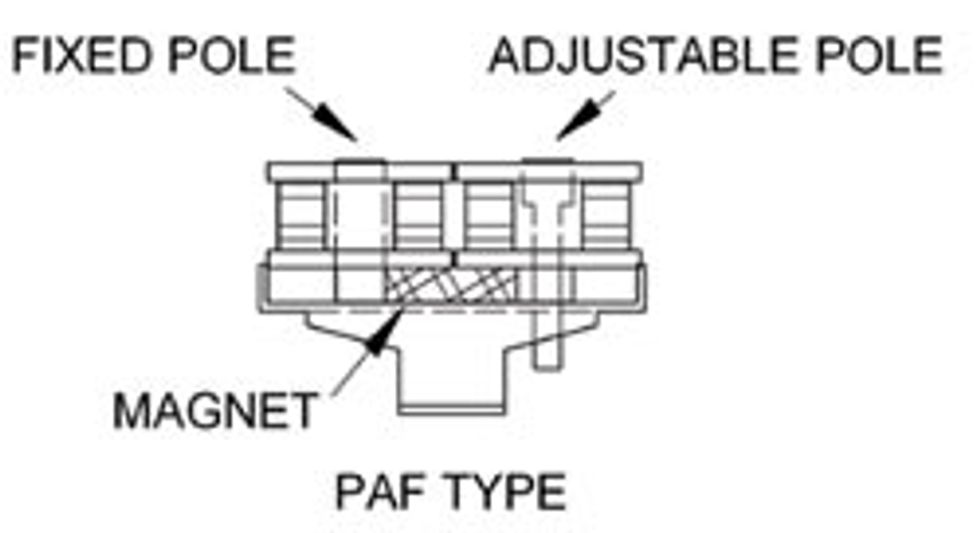
Humbuckers reject electrical signals that oscillate at 60 cycles per second. They do this by having two coils that are electrically out of phase with each other. One coil creates a positive voltage at 60 cycles, and one creates a negative voltage at 60 cycles, so when you combine the two signals they cancel each other out. The level of cancellation will be dependant on how closely the coils match. In practice, the coils don’t match exactly, so hum cancellation is never completely efficient. You can still get 120-cycle hum; the level is determined by how well the pickup and guitar wiring is shielded. 120-cycle noise is minimized with shielding, and 60-cycle is minimized with hum-cancelling pickup designs.
How do you get any sound at all if it cancels itself out? The coils are electrically out of phase with each other but magnetically in phase with each other. Strings are made of ferrous material (iron, steel and any blend of metals that have iron as part of the content), so in the best circumstance (matched coils) the only thing the pickup will sense is the ferrous material vibrating in the magnetic field. When the string vibrates, it causes the magnetic field to move through the coil. This induces an alternating current to be generated that corresponds to the string frequency, which is then converted to sound by your amplifier.
Gibson made three other humbucking pickup designs most people will be at least vaguely aware of: the mini-humbucker, the Firebird and the Johnny Smith. Pickups in the mini family have a different tone than the larger PAF for various reasons—some apply to all the smaller buckers and some are specific to each design. All of these secondary pickups are smaller: 2-5/8" x 1-1/8". The narrower width of these pickups (1-1/8" compared to 1-1/2") sense a shorter length of string vibration, containing only the higher harmonics generated by the string and giving you a slightly brighter and more focused sound.
The tone of the minis is also different due to how much iron is in their core—the size of the core and content affects the inductance of the pickup. Inductance has an effect on the output and frequency response. More inductance usually gives more output and more bass. So a smaller pickup sensing a more focused area of strings with a smaller amount of iron content in their core will result in a little less output and an overall slightly brighter, clearer sound.
A mini-humbucker is made like a miniature PAF pickup: it has one bar magnet positioned under each coil, with adjustable pole pieces made out of a ferrous alloy; the other coil contains a ferrous metal bar that is not adjustable. This corresponds to a PAF with adjustable poles in one coil and a series of metal slugs in the other coil. 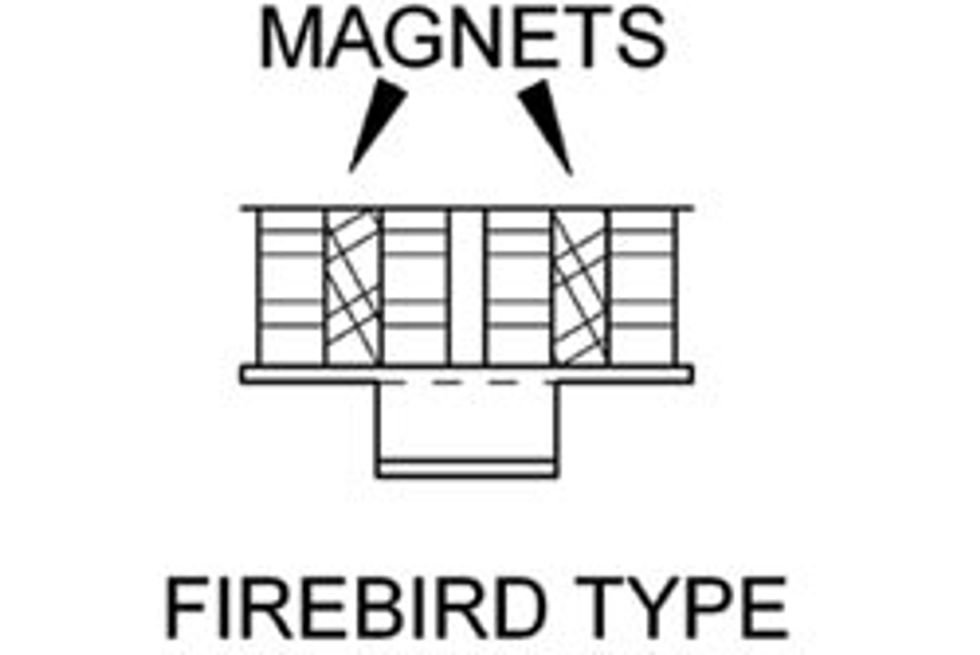
Steel cores tend to have a higher inductance; you get more bass and more output versus an alnico magnet core.
The mini-humbucker has a smoother attack with more sustain, and you’ll get more of a grind to the tone when you push your amp into distortion. Traditional Firebird pickups have a tighter, spankier tone that stays more defined when you really crank up your amp. 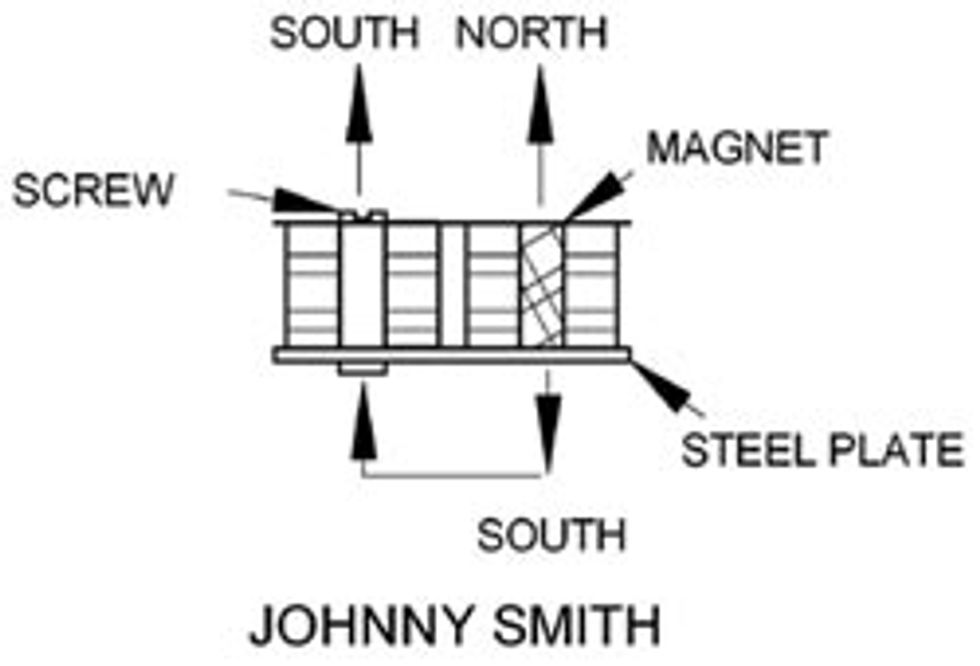
These small humbuckers were never very popular when they were first introduced. They tended to be overly microphonic and too bright. Recently, they have come back in to the spotlight. If they are made correctly they can be a very good pickup!
Jason makes extraordinary archtop, solid body and lap-steel guitars, and is a noted authority on nearly everything related to electric pickups; his book Basic Pickup Winding and Complete Guide to Making Your Own Pickup Winder sparked a new movement in boutique and aftermarket pickup manufacturing. lollarguitars.com
The history behind the fabled P-90
In the last column, George Ellison was going through the major pickup types, starting with the Strat single coil, which he called “the best” pickup. I’d have to agree that the Strat’s pickups are responsible for some of the greatest tones the electric guitar ever made. I love Strats, too, but I also have a special place in my heart for another single coil, one that’s older than the Strat: the venerable P-90.
During the sixteen years I’ve worked for Seymour Duncan, I’ve noticed a dramatic surge in the popularity of P-90s. In fact, no recent “movement” in pickups has been quite as strong as the renewed interest in these great-sounding tone beasts. Let’s look at the history of the P-90 and discuss its unique characteristics and advantages.
Gibson debuted their “Electric Spanish” line of guitars in the thirties as a way for guitarists to be heard, particularly in an ensemble format. Some of these early instruments, like the 1936 ES-150, used built-in, straight-bar, “Charlie Christian” pickups. Walt Fuller was the man responsible for this new design. This pickup eventually evolved into a rectangular-shaped, diagonally-slanted single coil unit with adjustable pole pieces. You could see these odd pickups on the ES-300, along with certain Gibson lap steels from 1940 to 1945. This transitional pickup was the big brother to the P-90, which Fuller developed in 1946, and which appeared on Gibson’s ES-175 and Switchmaster guitars shortly thereafter. Fuller used black thermo-formed plastic covers to house these pickups. And, like their predecessor, they used adjustable poles and Alnico magnets.
In the early fifties, Gibson began their official collaboration with the legendary Les Paul. It was in the spring of 1952 that the majestic Gold Top Les Paul debuted—featuring P-90 pickups. Back in the day, you could have one of these beauties for a mere $210. Sigh…
Some might argue that the P-90 was Gibson’s only truly successful single coil pickup. To me, the P-90 has the perfect blend of output and high-end response. Compared to the Strat, the tone is fatter, with more “beef” and more mids. Like the Strat pickup, traditional P-90s employ a single coil design with sandcast Alnico magnets. Unlike the Strat, the vintage P-90 uses a single conductor, braided shield hookup cable. The original P-90s were machine wound using 42 gauge, plain enamel magnet wire. Traditional P-90s use two magnets with opposing fields that face each other: the two south sides faced the screw pole pieces.
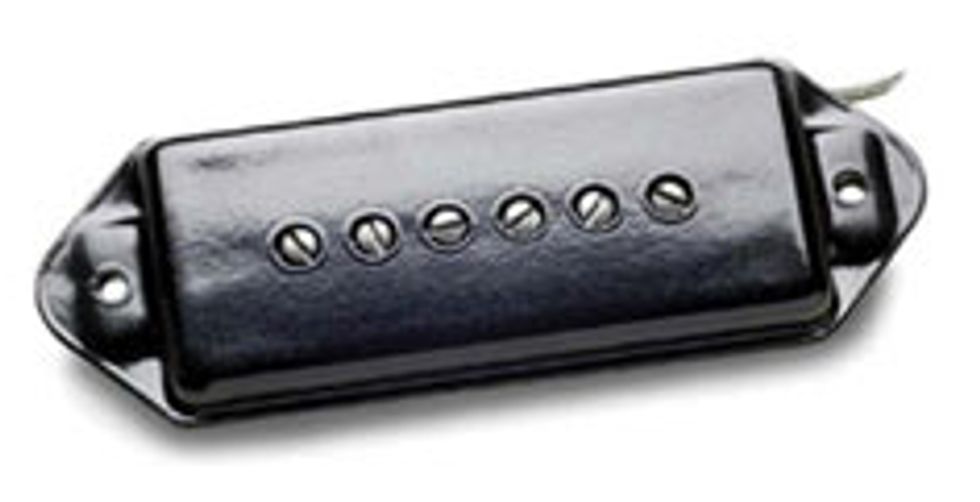 "Dog Ear" P-90 |
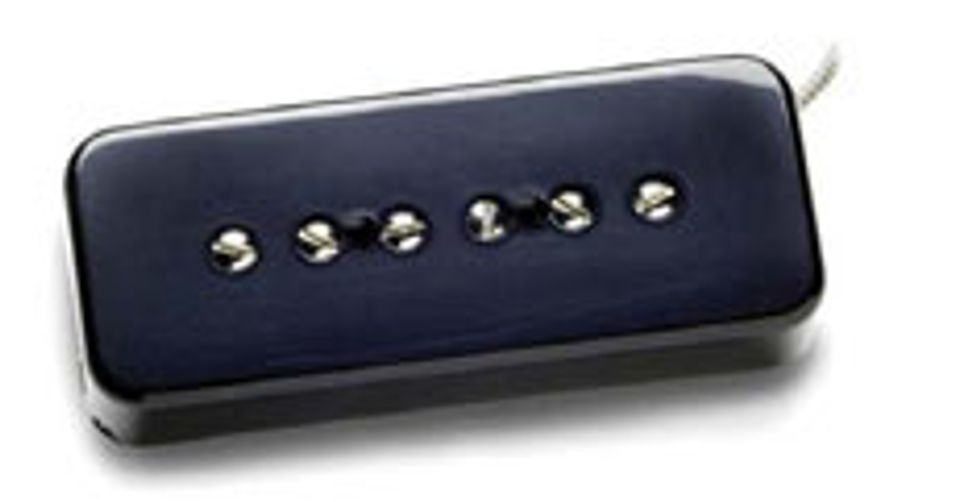 "Soap Bar" P-90 |
If you were around in the fifties and sixties, you could hear jazzers like Herb Ellis and the great Joe Pass using P-90s to produce “warm ‘n’ woody” tones, especially when used with the heavier gauge strings of the day. Other notable P-90 users have included Freddie King, George Thorogood, and Mountain’s Leslie West.
The nineties revival of swing and rockabilly music fueled a resurgance in traditional P-90 tones. Clever pickup manufacturers have figured out new ways of delivering P-90 flavors. Some have developed ceramic magnet P-90s used together with high-output coils for “Bad to the Bone” tone. Others have built hum-canceling P-90s that use a stacked-coil design, which not only cancels the hum found in all true single coil pickups, but also allows the player to switch between series, parallel and split wiring for even more tone options. Some offer P-90s housed under covers that make them direct, drop-in replacements for humbucker- equipped instruments. And still others offer full-size humbucker pickups that can split to a real-deal P-90.
So, whaddayathink? Are P-90s right for you? Well, if you like a big, fat, punchy tone with lots of single coil “cut,” and boosted mids, then you might be ready to take the P-90 plunge.
Evan Skopp is head of Marketing and OEM Sales for Seymour Duncan, based in Santa Barbara, California. He serves on the board of directors of Musician’s Institute in Hollywood and is past-president of the Guitar and Accessories Marketing Association.